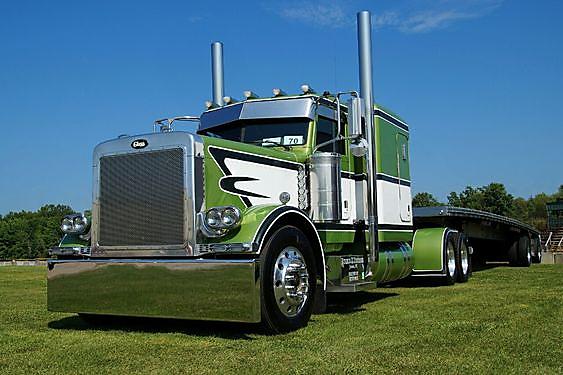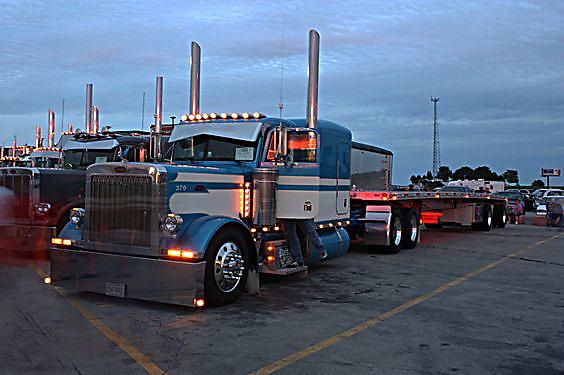When it comes to the professional trucking industry we often hear feedback from eager new truck drivers having trouble deciding between driving a dry van and driving flatbeds. We’ve decided to help make this useful guide to help those who are looking for extra ideas or reasons to make the switch.

Expect to get your hands dirty in Flatbed Trucking
Flatbed truck drivers can likely all agree that they are often thrown loads that are not the prettiest or cleanest as they are loaded in an open trailer with the walls of the trailer protecting the cargo. In return instead of the walls of the trailer becoming dirty, it often results in the tarps or loads themselves becoming dirty. When the load’s tarp or load itself becomes dirty it will likely always transfer to you. If you are a person who hates doing laundry, this style of professional trucking may not be the trucking of choice for you. You will either need to change clothes more often or end up washing your clothes more often as a flatbed trucker.
A few things to help make this easier while being on the road are including in your travel bag coveralls, a variety of several heavy-duty gloves of choice (also including Nitrate or Latex), and bath wipes. Bath wipes are one of the flatbed trucking industry’s biggest secrets as you can quickly remove road grime or oil from your hands or arms within a few minutes. This can greatly help to boost morale when on the road for longer periods of time when you may not come across a truck stop or area to get cleaned up while on the road.

The Differences in Loading Flatbed Trailers and Dry Vans
Almost all of the loading and unloading is done during the daytime with flatbed trucking from 7:00 am to 5:00 pm the majority of the time. This also helps keep flatbed truckers on a normal routine as they are also normally loading or unloading in the hours of 7:00 AM to 5:00 PM in the daylight. This also means that a majority of the truck driving that you will likely be doing as a flatbed truck driver will be in the daylight as well in order to work with a lot of the businesses inside of the flatbed trucking industry.
Whereas dry vans may be unloading or loading around the clock at warehouses in the middle of the night, early morning, or in the middle of the day. This also normally means that if you are a dry van driver you will be working around the clock on weird schedules during the week and could be easily unloading or loading a truck in the middle of the night at 2:00 am in the dark. This is due to many different warehouses or distribution centers being open 24 hours. This ultimately means you could receive your next load at any point around the clock of that day and must be prepared to wait several hours at certain points in order to do so.
Dry Vans are only able to be loaded from the back normally from a truck dock at a warehouse, distribution center, or manufacturing location. This ultimately can slow you down as there are only so many docks at each location and may cause you to wait until other drivers are done loading and unloading until a spot for your big rig is open. Unlike dry vans, flatbeds are able to be loaded from the side and from almost any location as they are primarily loaded using forklifts or cranes. This removes a lot of the extra added time by waiting for others and it helps you to have a much overall better experience

The Differences in Pay in Flatbed Trucking vs Dry Vans
The differences in pay in Flatbed Trucking and Dry Vans ultimately both depend on one thing when it comes to making money, Miles per year. The average amount of miles traveled per week in a flatbed can be anywhere from 1800 to 2600 miles per week on average. This comes with a slightly higher pay per mile, but overall fewer miles traveled during the week overall. Dry van trucking that can load or unload around the clock can typically get anywhere from 3200 to 3600 miles per week traveled and can expect to be paid at the end of the week at roughly the same as their counterparts as the pay per mile is normally less.
These amounts of miles per week can greatly vary depending on delays, time being able to be on the road per day and other numerous factors such as traffic delays. One of the noticeable added benefits of being a flatbed truck driver is the ability to sleep for longer as you are normally waiting for a place to open while loading or unloading.
The normal average page per year for a Dry Van Driver is $53,714 according to ZipRecruiter with the top earners making over $81,000 dollars. This is compared to a flatbed truck driver who may earn on average $53,163 dollars and top earners seeing over $75,000 dollars per year according to ZipRecruiter. The main difference between these two pays is the mileage. If you have more miles per week you will generally make more money. However, if you enjoy sleeping longer and are less in a rush to make almost the same amount of money then Flatbed Trucking might be for you.

Equipment Needed for Flatbed Trailers and for Dry Vans
Flatbed Equipment List:
• Headache Rack
• 3/8 Transport Chain – (Approximately 12 Chains and 12 Binders)
• 6 Foot Lader
• Coil Racks – Between 8 to 10 (extra is always better than not enough)
• Bungee Cords
• Moving Blankets
• Flatbed Tarp(s)
• 4 inch Flatbed Winch Straps – Approximately 20-30 at all times is a good number to have.
• Winches for securing Winch Straps
• Corner Protectors
Dry Van Equipment List:
• Ratchet Straps
• E Track Straps (E Track Cam Buckle Straps or E Track Ratchet Straps)
• E Track Rails
• Broom
• Stretch Wrap
• Corner Protectors
The Benefits of a Flatbed Truck Driver
The number one benefit that most professional flatbed truck drivers talk about the most is the schedule and the challenge of the job. This job is one of the more challenging trucking jobs, but it also comes with some major rewards as well such as being able to drive mostly in the daylight. Although you will become dirtier more often you are mostly able to drive less providing you with the time to clean up and get to bed earlier than the dry van counterpart. When it comes to getting paid you will often find out that it’s almost identical to dry vans but one major catch – you are getting paid the same pay to drive fewer miles.
The Benefits of a Dry Van Truck Driver
The number one benefit for most dry van drivers is job security. There is almost always an endless amount of household goods that are needing to be transported to their destination to meet strict deadlines. As there is currently a driver shortage the amount of taking on more work opportunities is just about endless currently being a dry van driver. Although the miles pay less per mile the overall pay is much higher than those who are not primarily dry van drivers. Long hard hours are normally met with high rewards for those who are able to take on the challenge by earning a great living.
Frequently Asked Dry Van and Flatbed Questions
Is a Box Truck Considered a Dry Van? – Technically speaking a box truck is a type of dry van but not exactly the first image that people think of when they think of dry vans. The normal image that everyone has of dry vans is semi-trucks that are being pulled down the road by big rigs normally.
Do Flatbed Trailers Require More Physical Requirements? – Yes, typically flatbed trailers are not loaded at docks and rather at job sites making it physically harder. This requires the driver to climb onto and off of the trailer numerous times when securing cargo or tarp systems.
Does the big rig matter based on the trailer? – Yes, and no. Almost every dry van application requires a semi-truck, whereas some flatbed drivers may use commercial pickup trucks that are diesel for some of the lighter in physical weight securement applications. Although, the vast majority of all dry van and flatbed trailers do indeed require a big rig in order to move the heavy physical weight equipment or goods.
Are Flatbed Truck Driving Jobs Harder To Obtain? – Although the driving requirements are the same for both jobs it may be more difficult to get into a flatbed trucking job due to oversized loads and the jobs requiring more on the road experience. This can greatly vary on the different types of cargo you will be securing and may be different on a job-to-job basis.









